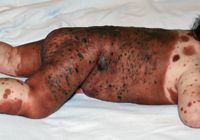- Case-Based Roundtable
- General Dermatology
- Eczema
- Chronic Hand Eczema
- Alopecia
- Aesthetics
- Vitiligo
- COVID-19
- Actinic Keratosis
- Precision Medicine and Biologics
- Rare Disease
- Wound Care
- Rosacea
- Psoriasis
- Psoriatic Arthritis
- Atopic Dermatitis
- Melasma
- NP and PA
- Skin Cancer
- Hidradenitis Suppurativa
- Drug Watch
- Pigmentary Disorders
- Acne
- Pediatric Dermatology
- Practice Management
- Prurigo Nodularis
- Buy-and-Bill
Article
For certain congenital melanocytic nevi, surgery not the answer
Author(s):
Since there is insufficient evidence to recommend for or against prophylatic surgery for patients with congenital melanocytic nevi, physicians need to tailor management based on factors such as the size, thickness and locations of lesions for each patient, an expert says.

Key Points

"The main impetus for prophylactic excision of CMN stems from the knowledge that the relative risk for developing melanoma in patients with CMN is high: fourfold to 1,046-fold, depending on nevus size, versus matched patients without CMN," says Ashfaq Marghoob, M.D., head, Hauppauge dermatology section, Memorial Sloan-Kettering Cancer Center, Hauppauge, N.Y.
Overall, he says, "The risk for malignant melanoma (MM) and neurocutaneous melanoma (NCM) is highest for patients with large CMN (LCMN), especially for those that are very large (>40–60 cm in diameter). Furthermore, in patients with LCMN, the risk for cutaneous MM and NCM appears to be related to the size of the large CMN, its location and, in the case of NCM, the number of satellite nevi," Dr. Marghoob says.

As for the location of the primary melanoma, Dr. Marghoob says that in three prospective studies of patients with CMN, to date researchers have not observed any cutaneous melanomas develop during prospective follow-up (NOI-LCMN registry. Unpublished data, March 2009. Bittencourt FV, Marghoob AA, Kopf AW. Pediatrics. 2000 Oct;106(4):736-741. Zaal LH, Mooi WJ, Klip H, van der Horst CM. Plast Reconstr Surg. 2005 Dec;116(7):1902-1909).
However, "About 7 percent of these patients develop extracutaneous melanoma or NCM," Dr. Marghoob says.
The reason that no cutaneous melanomas have been detected on prospective follow-up may in part be due to insufficient follow-up time, he adds. He also says the most recent retrospective studies have indeed found that about 2 percent of patients with LCMN developed melanoma on the skin (Bett BJ. J Am Acad Dermatol. 2005 May;52(5):793-797. Kinsler VA, Birley J, Atherton DJ. Br J Dermatol. 2009 Jan;160(1):143-150. Epub 2008 Oct 22).
"Regarding melanoma risk in relation to CMN location, one of these studies shows that there is a predilection for melanoma to arise in CMN on the trunk, as opposed to nevi on the head and limbs," Dr. Marghoob says.
For NCM, he adds, "The larger the nevus, the greater the risk. The risk appears greatest for CMN measuring more than 40 to 60 cm."
Location of the CMN does not appear to play a significant role in determining the risk for NCM development, although the greater the number of satellite nevi, the higher the risk of NCM (Marghoob AA, Dusza S, Oliveria S, Halpern AC. Arch Dermatol. 2004 Feb;140(2):171-175). In the latter area, a recent retrospective study has shown that the risk can be up to 76 percent (Bett BJ. J Am Acad Dermatol. 2006 May;54(5):767-777. Epub 2006 Feb 2), Dr. Marghoob adds. "And these patients often manifest neurological symptoms," he says.






